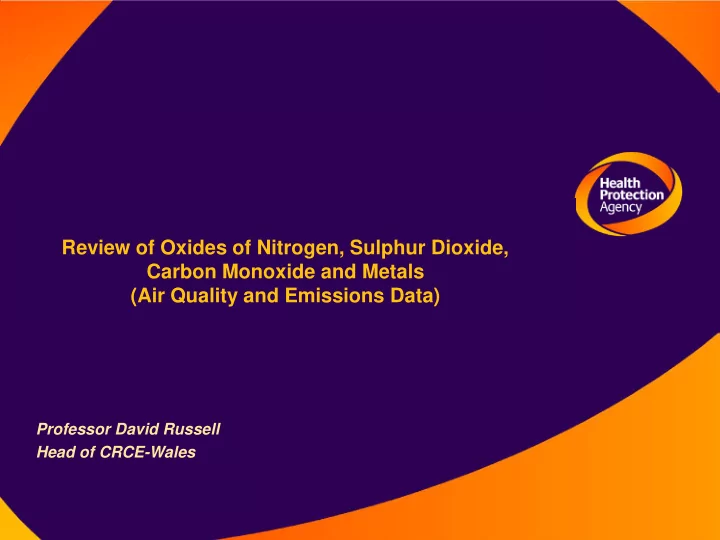

Review of Oxides of Nitrogen, Sulphur Dioxide, Carbon Monoxide and Metals (Air Quality and Emissions Data) Professor David Russell Head of CRCE-Wales
Objectives • To review available data on local air quality with respect to oxides of nitrogen (NO x ), Sulphur Dioxide (SO 2 ) and Carbon Monoxide (CO), and to compare with National Air Quality Standards (NAQS) and Air Quality Objectives (AQO). • To review the impact of commissioning Kiln 4 on local air quality. • To assess heavy metals emissions from the plant operations and potential impact upon public health. • To ascertain the likely impact upon health of local air quality.
Principal Pollutants •Oxides of nitrogen (NOx) •Sulphur dioxide (SO 2 ) •Carbon monoxide (CO) •“Acid gases” e.g. hydrogen fluoride (HF) hydrogen chloride (HCl) •Metals •(Particulates and dioxins)
Toxicology • NO 2 -Respiratory irritation, exacerbation of asthma. May be due to particulates. • SO 2 - respiratory irritation; asthmatics may be more sensitive. • CO-asphyxiant. Susceptible individuals include those with CHD. • Acid gases- strong sensory irritants and corrosive gases. • Metals-toxicology varies according to metal. Hg- nephrotoxic, Pb-neurotoxic.
Air Quality Standards/Objectives • Standards- concentrations of pollutants adopted to achieve a certain level of environmental quality based on health and on the environment (DEFRA, 2007). • Objectives - policy targets expressed as average concentrations over a specified time period +/- exemptions or exceedences within a given time period. Source: DEFRA (2007)
Air Quality Index: banding for susceptible individuals
UK Air quality 2001-2009 (NAEI)
Regional air quality: Flintshire (NOx and SO 2 )
Total UK emissions 1970-2008: CO, SO 2 , NOx CO SO2 NOx 12000 Total UK 10000 KiloTonnes 8000 6000 4000 2000 0 Year CO SO2 NOx 1600 Cement & 1400 manufacturing 1200 KiloTonnes 1000 800 600 400 200 0 Year
Total UK emissions 1970-2008: metals 140 Arsenic Cadmium 120 Mercury Tonnes pre year 100 Selenium 80 60 40 20 0 1970 1975 1980 1985 1990 1995 2000 2005 2010 Year
Regional sources of emissions: NOx, SO 2 (2011) . NOx SO 2
Hanson Cement: contribution to emissions (NOx, SO2 , CO and metals) 2009
Hanson Cement; CO and SO 2 emissions 1998-2009
Stack emissions: kilns 1-4 (NOx, SO 2 and metals) 0.25 Kiln 1 and 2 Mercury (Hg) Kiln 3 0.20 Kiln 4 ELV Mercury 0.15 mg/m 3 0.10 0.05 0.00 2000 2002 2004 Jul- Jan - Jul - Jan - July - Jan - Jul - Jan - Jul - Dec Jun Dec Jun Dec Jun Dec Jun Dec 05 06 06 07 07 08 08 09 09 Monitoring Occasion 0.10 Kiln 1 and 2 Kiln 3 0.09 Kiln 4 Cadmium (Cd) 0.08 ELV Cadmium Thallium 0.07 0.06 mg/m 3 0.05 0.04 0.03 0.02 0.01 0.00 2000 2002 2004 Jul- Jan - Jul - Jan - July - Jan - Jul - Jan - Jul - Dec Jun Dec Jun Dec Jun Dec Jun Dec 05 06 06 07 07 08 08 09 09 Monitoring Occasion
Local monitoring locations N X HC; Mold (LA): EA MMF; HC monitor
Local Authority Monitoring; NO 2 diffusion tubes 1999-2009
Local ambient air quality-Environment Agency (NOx and SO2) 2000-2007 NOx SO 2
Local ambient air quality-Hanson Cement (NOx and SO 2 ) 2005-2009
Local Air Quality Index: NOx, SO2 and CO exceedences 2005-2009
Local ambient monitoring; metals Penyffordd (2001).
Conclusions • There has been a reduction in modelled emissions of NOx and SO 2 from 2000-2009 from all UK sectors. • Regional reduction in ambient levels of NOx, SO 2 and CO. • There are several regional sources of atmospheric pollutants, natural and man-made, indoor and outdoor. • Regional emissions of NOx, SO 2 and CO appear closely geographically related to traffic density. • Gaseous emissions from Hanson Cement of NOx, SO 2 and CO have declined over the study period.
Conclusions (continued) • Ambient monitoring for metals is limited, but a study in 2001 did not demonstrate exceedence of respective standards. • Stack emissions of NOx, SO 2 and CO generally meet permit levels, with a trend of reducing emissions since kiln 4. • Majority of metal emissions do not exceed the Waste Incineration Directive (WID) and compare favorably with other similar installations. • Contribution of Hanson Cement to environmental pollutants is up to 38% of regional sources • Local air quality is good and improving • Ambient pollution concentrations consistently remain within the “low” pollution band of the AQI.. • The impact upon public health is unlikely to be significant.
Recommend
More recommend